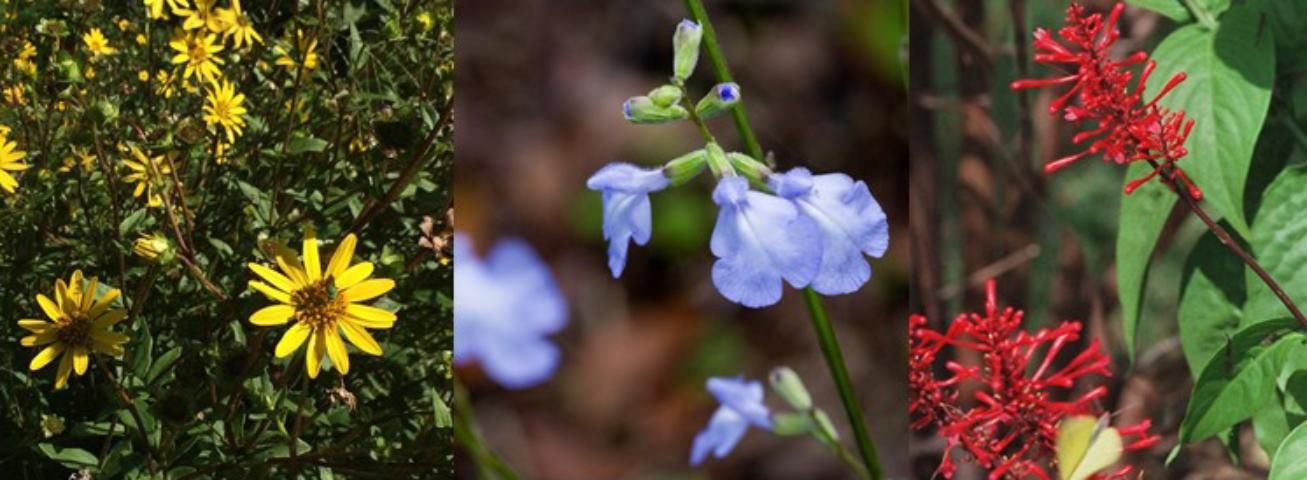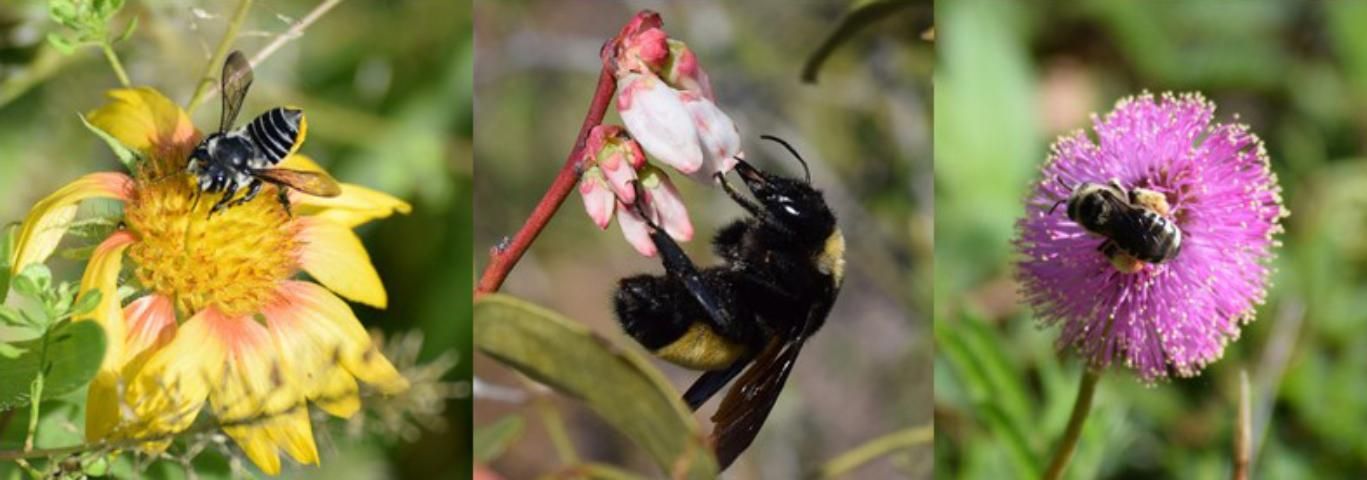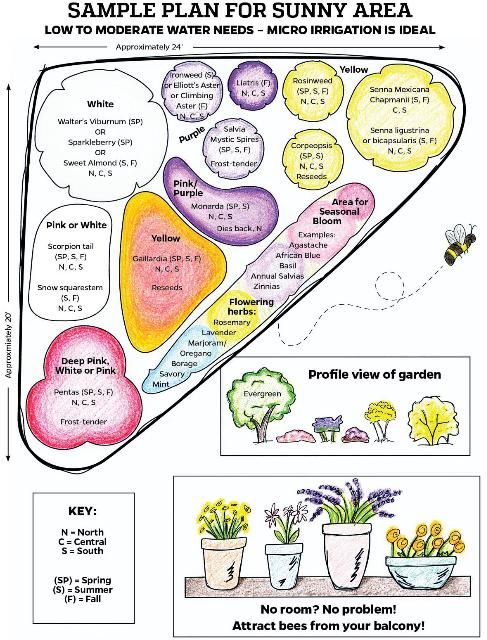Introduction
Florida is home to approximately 315 species of native wild bees. These bees rely on flowers for survival; their diets consist exclusively of pollen and nectar harvested from flowers. Recently reported declines in some bee species have heightened awareness of bee conservation across the United States and motivated efforts to increase floral resources for bees (Biesmeijer et al. 2006; Colla and Packer 2008; Ricketts et al. 2008; Potts et al. 2010; Burkle et al. 2013). Gardeners and land managers can aid in conservation efforts by planting flowers for bees in home or community gardens.
Bee-Friendly Plants
Generally, the best plants for bees will be those that have abundant and accessible pollen and nectar. Avoid pollen-free plant varieties (e.g., some sunflowers and lilies) because they will not provide pollen, which is the essential food source for bees. Additionally, choose plants with flat flowers or short to medium-length flower tubes (corollas), and limit plants with long flower tubes such as honeysuckle (Figure 1). Many native wild bees have relatively short proboscises, or tongues, and may not be able to access nectar from flowers with long tubes; however, flowers with long floral tubes can attract other pollinators with long tongues or beaks such as butterflies, moths, and hummingbirds.

Credit: R. Mallinger and UF/IFAS
Increasing the number of flowering plant species in your garden can increase the abundance and diversity of bees attracted to the garden (Kearns and Oliveras 2009; Pardee and Philpott 2014; Blauuw and Isaacs 2014). Aim for at least ten flowering plant species selected to complement one another (Williams et al. 2015; Mader et al. 2011). Specifically, design your garden to have three or more different plants blooming at any given time during the growing season, which is year-round in southern Florida, and March through November in northern areas of the state. Because bees often prefer dense floral displays, arranging flowering plants in clumps with multiple individuals per species will increase the attractiveness of the garden to bees (Blaauw and Isaacs 2014; Williams et al. 2015; Mallinger et al. 2019).
Additionally, bees prefer white, yellow, or blue-purple flowers (Figure 2). Orange, pink, or red flowers are not as attractive to bees (but may be attractive to other pollinators). Finally, native plants are generally best for native bees (Isaacs et al. 2009; Morandin and Kremen 2012; Pardee and Philpott 2014). While bees may collect nectar from a variety of native and non-native plants, some specialist native bees require pollen from certain native plants in order to develop optimally. Non-native plants may provide abundant nectar for bees during times, or in places, with minimal native floral resources and can be useful in combination with native plants to increase resource availability.

Credit: Weaver and R. Mallinger, UF/IFAS
Designing and Managing a Garden for Native Bees
You can provide flowers for native bees by simply incorporating bee-friendly plants into your existing landscape, or you can create a special space for them in your yard by incorporating some easy design ideas (Figure 3). Create a landscape design for any garden space that you plan to make changes to, no matter how big or small. The faculty, staff, and Master Gardener Volunteers at the UF/IFAS Extension Office in your county can assist you with basic garden design concepts and may even offer classes on landscape design. Some additional elements to incorporate into your pollinator garden include:
- Install plants of varying heights to increase visual appeal of the garden space, being sure to pay attention to the average height and width of the mature plant/tree.
- Limit weed barriers including fabric and plastic sheets or dense wood and straw mulches. If you do use heavy weed barriers, keep some amount of area near the bee garden free of these barriers. Many native bees nest below the ground in tunnels or cavities like abandoned rodent nests and need bare or lightly covered soil. If you see a small mound of dirt with an entrance/exit hole on top, you may have a friendly resident!
- Add a bee nest box for the native bees that build their nests above ground (http://gardeningsolutions.ifas.ufl.edu/design/gardening-with-wildlife/pollinator-hotels/ and https://www.dropbox.com/sh/gx7lae6qx7j23ev/AAAF-3qgh0_hV3z-gs2l-0lua/Creating%20a%20Pollinator%20Hotel.pdf?dl=0).
- Avoid pesticide use in and around your garden, especially on plants that are blooming. It is best to avoid all chemicals on plants during their bloom period, including fungicides and organic pesticides because they may harm bees that visit the flowers. If you do use pesticides during the flowering period, apply them in the evening hours, and always follow pesticide label instructions.
- When purchasing seeds or transplants, it is best to buy ones that have not been treated with systemic insecticides such as neonicotinoids because these systemic chemicals can persist in the plant and may be present in the pollen and nectar.

Plant Recommendations for Florida
Below are lists of plants that we recommend for native bees in northern, central, and southern Florida. These plants have floral traits expected to attract native bees, including attractive flower color, size, and shape. They also contain abundant nectar and/or pollen. While most of the suggested plants are native, some bee-attracting non-native plants are also included. This list should be used as a starting point, though it is not exhaustive. When evaluating plants for native bees, you can use the above criteria to consider plants not on this list. When choosing plants for your area, keep in mind the soil, moisture, and light requirements of the plants (https://ffl.ifas.ufl.edu/pdf/FYN_Plant_Selection_Guide_2015.pdf). Most bee-attracting plants grow in full sun, though some will thrive in partial shade.
References
Biesmeijer, J. C., S. P. M. Roberts, M. Reemer, R. Ohlemüller, M. Edwards, T. Peeters, A. P. Schaffers, S. G. Potts, R. Kleukers, C. D. Thomas, J. Settele, and W. E. Kunin. 2006. "Parallel declines in pollinators and insect-pollinated plants in Britain and the Netherlands." Science 313 351–354. DOI: 10.1126/science.1127863
Blaauw, B. R., and R. Isaacs. 2014. "Larger patches of diverse floral resources increase insect pollinator density, diversity, and their pollination of native wildflowers." Basic and Applied Ecology 15 701–711. DOI: 10.1016/j.baae.2014.10.001
Burkle, L. A., J. C. Marlin, and T. M. Knight. 2013. "Plant-pollinator interactions over 120 years: Loss of species, co-occurrence, and function." Science 339 1611–1615. DOI: 10.1126/science.1232728
Colla, S. R., and L. Packer. 2008. "Evidence for decline in eastern North American bumblebees (Hymenoptera: Apidae), with special focus on Bombus affinis Cresson." Biodiversity Conservation 17 1379–1391. DOI:10.1007/s10531-008-9340-5
Isaacs, R., J. Tuell, A. Fiedler, M. Gardiner, and D. Landis. 2009. "Maximizing arthropod-mediated ecosystem services in agricultural landscapes: The role of native plants." Frontiers in Ecology and the Environment 7 196–203. DOI:10.1890/080035
Kearns, C. A., and D. M. Oliveras. 2009. "Environmental factors affecting bee diversity in urban and remote grassland plots in Boulder, Colorado." Journal of Insect Conservation 13 655–665. DOI:10.1007/s10841-009-9215-4
Mader, E., M. Shepherd, M. Vaughan, S. Black, and G. LeBuhn. 2011. Attracting Native Pollinators. Storey Publishing, North Adams, Massachusetts, 1–385.
Mallinger, R. E., J. G. Franco, D. A. Prischmann-Voldseth, and J. R. Prasifka. 2019. "Annual cover crops for managed and wild bees: Optimal plant mixtures depend on pollinator enhancement goals." Agriculture, Ecosystems & Environment 273 107–116. DOI: 10.1016/j.agee.2018.12.006
Morandin, L. A., and C. Kremen. 2013. "Bee preference for native versus exotic plants in restored agricultural hedgerows." Restoration Ecology 21 26–32. DOI: 10.1111/j.1526-100X.2012.00876.x
Pardee, G. L., and S. M. Philpott. 2014. "Native plants are the bee's knees: Local and landscape predictors of bee richness and abundance in backyard gardens." Urban Ecosyst 17 641–659. DOI: 10.1007/s11252-014-0349-0
Potts, S. G., J. C. Biesmeijer, C. Kremen, P. Neumann, O. Schweiger, and W. E. Kunin. 2010. Global pollinator declines: Trends, impacts and drivers. Trends in Ecology & Evolution 25 345–353. DOI: 10.1016/j.tree.2010.01.007
Ricketts, T. H., J. Regetz, I. Steffan-Dewenter, S. A. Cunningham, C. Kremen, A. Bogdanski, B. Gemmill-Herren, S. S. Greenleaf, A. M. Klein, M. M. Mayfield, L. A. Morandin, A. Ochieng, S. G. Potts, and B. F. Viana. 2008. "Landscape effects on crop pollination services: Are there general patterns?" Ecology Letters 11 499–515. DOI: 10.1111/j.1461-0248.2008.01157.x
Williams, N. M., K. L. Ward, N. Pope, R. Isaacs, J. Wilson, E. A. May, J. Ellis, J. Daniels, A. Pence, K. Ullmann, and J. Peters. 2015. "Native wildflower plantings support wild bee abundance and diversity in agricultural landscapes across the United States." Ecological Applications 25 2119–2131. DOI: 10.1890/14-1748.1